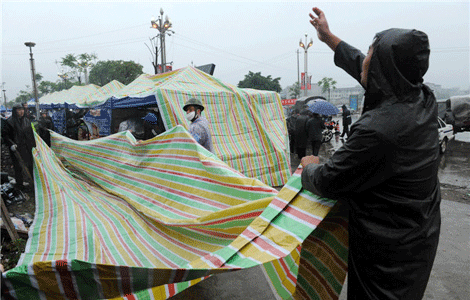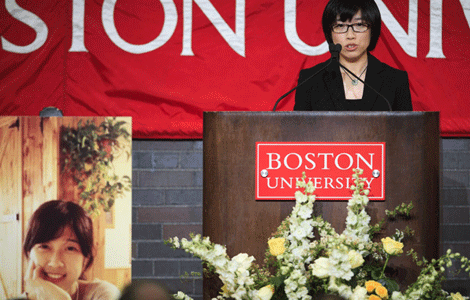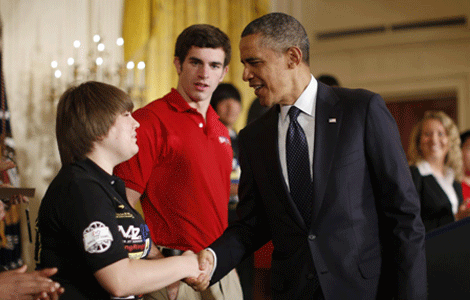Fears of radiation remain headache for Japan
Updated: 2012-03-09 19:06
(Xinhua)
|
||||||||
TOKYO - Almost one year has passed since Japan was hit by devastating earthquake and tsunami, residents, especially those from the quake-hit areas, are still haunted with fears of radioactive contamination resulted from the worst nuclear accident triggered by the twin disasters.
In December 2011, the Japanese government declared the damaged reactors at the crippled Fukushima No 1 nuclear power plant had reached a state known as "cold shutdown" .
The announcement came nine months after a massive earthquake- triggered tsunami knocked out the plant's vital cooling systems causing the reactors to meltdown and sparking a nuclear crisis on a level unseen globally for 25 years.
Considered by many as a major step forward, the move also draw fire from observers and local officials.
The governor of Fukushima Prefecture Yuhei Sato said the residents were still anxious.
"The biggest problem we have in mind is the possibility that we will not be able to continue with the cooling system," Hosono told a press conference last December in Tokyo.
According to Hosono, another risk was the possibility of contaminated water leaking.
The Tokyo Electric Power Co (TEPCO), the operator of the troubled nuclear power plant, came under heavy pressure.
Plant manager Takeshi Takahashi told media in a recent tour of the site that his task was to make sure reactors 1 to 4 were safe and stable and ensure no radioactive substances leak.
"Our main challenge now is to remove the nuclear fuel from the reactors. It's a technically very difficult problem, but we want to take it step by step."
TEPCO officials explained that about 3,000 people work at any one time at the entire nuclear plant. But according to weather agencies, the plant is still leaking radioactive materials into the environment.
About 36 percent of evacuees from Fukushima Prefecture who responded to a Kyodo poll said they were unwilling to return home.
Many respondents expressed anxieties over radiation from the crippled nuclear power plant. The number of people who evacuated from the northeastern prefecture stood at 62,674 by February 23, according to local government.
Analysts said the nuclear crisis had cost the government some of its credibility as residents refused to believe what they were told by the government.
In the food stores across Tokyo, the prices of strawberry produced in prefectures like Fukushima and Tochigi are lower than those produced in prefectures west of Tokyo, including Shizuoka and Nagano, though the produce coming from northeastern prefectures is said to be safe to eat.
The fear over radiation also resulted in the slow progress in disposing debris in the quake-hit prefectures. Touring around some coastal places hardest hit by the tsunami, one will find debris pile as high as 20 meters.
Yoshihiro Murai, governor of the quake-hit Miyagi Prefecture, told a press conference on Wednesday that the prefecture planned to have 3.5 million tons of debris taken over by other prefectures. "At present, we are only able to find recipients for 150,000 tons, "he said.
Murai said there were fears that some of this debris contaminated with radioactivity.
Observers said it would be a time-consuming process to dispel the fear of radioactive contamination and an urgent task for the government if it wanted to facilitate reconstruction.

 Relief reaches isolated village
Relief reaches isolated village
 Rainfall poses new threats to quake-hit region
Rainfall poses new threats to quake-hit region
 Funerals begin for Boston bombing victims
Funerals begin for Boston bombing victims
 Quake takeaway from China's Air Force
Quake takeaway from China's Air Force
 Obama celebrates young inventors at science fair
Obama celebrates young inventors at science fair
 Earth Day marked around the world
Earth Day marked around the world
 Volunteer team helping students find sense of normalcy
Volunteer team helping students find sense of normalcy
 Ethnic groups quick to join rescue efforts
Ethnic groups quick to join rescue efforts
Most Viewed
Editor's Picks

|

|

|

|

|

|
Today's Top News
Health new priority for quake zone
Xi meets US top military officer
Japan's boats driven out of Diaoyu
China mulls online shopping legislation
Bird flu death toll rises to 22
Putin appoints new ambassador to China
Japanese ships blocked from Diaoyu Islands
Inspired by Guan, more Chinese pick up golf
US Weekly

|

|







